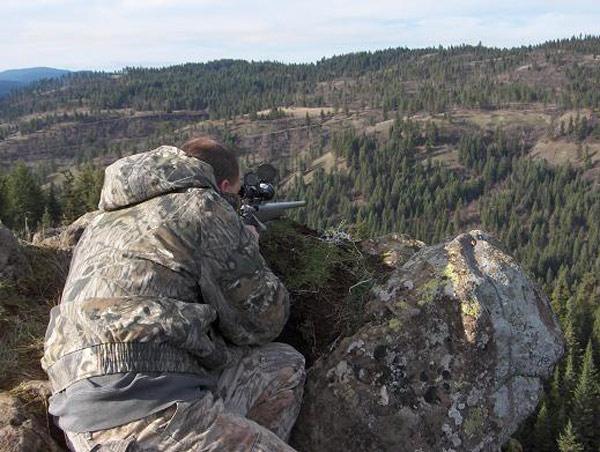Long Range Hunting Ambush

If you and your equipment can only shoot one foot at 500 yards you have no business looking at shots beyond that. Now let's say that you and your rifle can shoot a group in the range of 5 inches at 500 yards. If I determine that this is my maximum range, this will likely be the last group I shoot. I have now got my drop figures and an idea of my rifles accuracy at a given distance. Now I go to places during the off season where I can shoot up / down hill, across canyons with wind and thermals etc. I shoot these field shots at a 10" disk. My only concern is that I hit it the first shot. Long range hunting is not all about equipment and small group size. It is by far mostly about reading conditions and being able to shoot in them. My criteria for a taking a shot is that it have a high probability for a first round hit. Some people think that long range shooting is unethical. I don't see long range shooting of big game animals any differently than the hunter shooting at a 100 yard running whitetail in a brushy bottom. For some people it is a high probability shot and others it is a high probability of making noise and at best wounding a game animal.
Now with our rifle and scope all dialed in for the long range hunting areas we just need to locate them. I start by looking an aerial photos and topographic maps for a piece of high ground that looks across to or down on a terrain feature I like. Saddles, trails through brush patches between feeding and bedding areas, water sources and travel funnels are the kind of areas I want to over look. When I locate a likely area I look for a location that gives the best shooting advantages. I look for sun direction during the time I intend to hunt it, uphill / down hill issues, I prefer to shoot up or down a canyon instead of across it, I look for access from my shooting position to the target area, I look for terrain features that cause swirling wind conditions and most importantly I look a good route to and from my shooting location. My favorite is to find a spot where I can sneak up the back side of a ridge and look over a spot that is impossible to hunt through. When I'm done I can slip out the way I came in.
Once I have mapped out some potential locations I go to them with my day pack and long range tools. I take my range finder, binoculars, spotting scope, paper and a pen. I follow my approach route in and find a suitable firing position. I bust out the range finder to check some distances to make sure I have not picked a location that is beyond my abilities. Once satisfied with the location of my firing position I make a range card.
The range card is a key tool in the long range ambush. I use a graduated arc military style range card. On my range card I have, the location of my firing position, major land marks, trail intersections and a center focal point to base the card off of. The focal point needs to be something that you and / or your partner can identify quickly and easily. It helps if the focal point is located somewhere in the center of the ambush area. Once this is done, yardages are assigned to the plot points on the card and any special shooting conditions (uphill / downhill etc.). I also divide the card into sections based on obvious terrain features. This allows you to work a section over and your partner another without overlapping. Range cards allow the shooter to show up to a site and start to try to locate game. Once the game is located you may have a small window of opportunity to engage the animal. With the card you simply locate, dial elevation, adjust for wind etc and engage, without moving from behind the rifle. Range cards are a huge time saver. I also keep notes about shooting conditions on the back side of the card for future use.
Now the time has rolled around to hunt our site. We have selected a time to hunt say from 12:00 until dark. We sneak into our site undetected by using our predetermined travel route. We setup our now rather extensive pile of equipment, rifle, spotting scope, rear bag, wind speed meter, and range card. I have found a few other things that can be really helpful, a rubber padded tree stand step for shooting up at a steep angle, a tree stand rain cover to keep rain off of optics and myself, and a book in case I have trouble staying focused.
